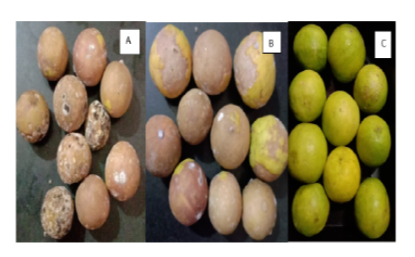


Indian Journal of Science and Technology
Year: 2022, Volume: 15, Issue: 3, Pages: 136-145
Original Article
Mini K Paul1*, K D Mini2, Anu Ruby Benn1, Jyothis Mathew3
1Department of biosciences, MES college, Aluva7, Kerala, Marampally, Ernakulam, India
2Assistant Professor, Department of Zoology, Sree Sankara college, Kerala, Kalady,
Ernakulam, India
3Professor, School of Biosciences, MG University, Kottayam, Kerala, India
*Corresponding Author
Email: [email protected]
Received Date:22 December 2021, Accepted Date:15 January 2022, Published Date:04 February 2022
Background of the study: As fungi become resistant to commonly used pesticides, fungicides are becoming not only more expensive, but also less effective in controlling postharvest infections. New chitinase immobilisation techniques are urgently needed to minimize enzyme costs while enhancing bio catalytic performance, antifungal activity, enzyme stability, and reusability. Objectives: The objective of this study was to immobilise chitinase of Kurthia gibsonii Mb126 by entrapping it in calcium alginate beads and to analyse its antifungal activities against Aspergillus flavus. Methods: The optimal parameters influencing the immobilization process and the characteristics of soluble and immobilised chitinase of K. gibsonii Mb126 were analysed. The antifungal activities of immobilised and free chitinase of K. gibsonii Mb126 against A. flavus, which was isolated from decayed lemon fruit, were performed using the agar-disk diffusion method. Free chitinase 25.0 mL (0.8 U/mL) and immobilised chitinase 0.06 g (specific activity 124–192 U/mg) were treated on separate lemon fruits for testing antifungal activity against A. flavus. Findings: K. gibsonii Mb126 chitinase was immobilised perfectly in calcium alginate beads. After optimising process parameters of immobilisation (sodium alginate concentration 3%, calcium chloride 0.2 M, 120 min. curing time), the specific activity of K. gibsonii Mb126 immobilised chitinase improved to 11.9-fold greater than the free form of chitinase and the immobilisation yield increased to 84%. It was observed that the thermal stability and storage stability of immobilised chitinase were better than those of free enzymes. The immobilised chitinase could be reused, and it retained 78% activity even after 16 cycles. The surface morphology of immobilised chitinase was observed in a scanning electron microscope at different magnification powers. Enzyme kinetics was studied and compared with that of its chitinase soluble counterpart. An in vitro study demonstrated that immobilised chitinase of K. gibsonii Mb126 has higher antifungal activity against A. flavus. In vivo experimental study of theantifungal nature of chitinase in lemon fruits infected by A. flavus indicated that immobilised chitinase significantly decreased the incidence of postharvest decay. Conclusion: The immobilised chitinase of K. gibsonii Mb126 can be utilised as an important source of sustainable and environmentally friendly fungicides to prevent pathogens and saprophytic fungi from food. Novelty: To the best of our knowledge, this is the one and only study report about the antifungal nature of immobilised chitinase against a fungus that causes postharvest decay in lemon fruits.
Keywords: Kurthia gibsonii Mb126; Aspergillus flavus; immobilised chitinase; postharvest decay of lemon; sodium alginate
© 2022 Paul et al. This is an open-access article distributed under the terms of the Creative Commons Attribution License, which permits unrestricted use, distribution, and reproduction in any medium, provided the original author and source are credited.
Published By Indian Society for Education and Environment (iSee)
Subscribe now for latest articles and news.